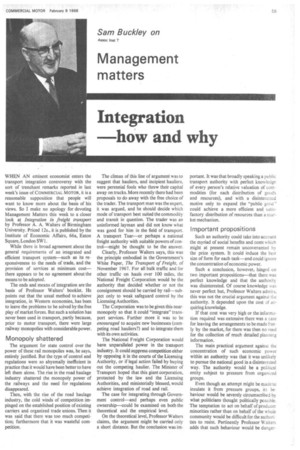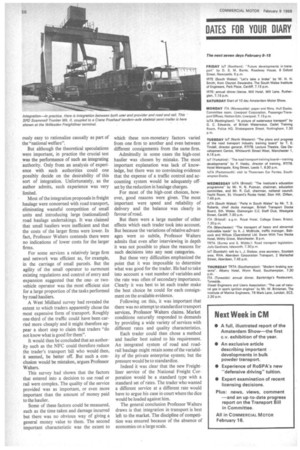Integration how and why
Page 57

Page 58

If you've noticed an error in this article please click here to report it so we can fix it.
WHEN AN eminent economist enters the transport integration controversy with the sort of trenchant remarks reported in last week's issue of COMMERCIAL MOTOR, it is a reasonable supposition that people will want to know more about the basis of his views. So I make no apology for devoting Management Matters this week to a closer look at Integration in freight transport by Professor A. A. Walters of Birmingham University. Priced 12s., it is published by the Institute of Economic Affairs, 66a, Eaton Square, London SW1.
While there is broad agreement about the general requirements of an integrated and efficient transport system—such as its responsiveness to the needs of trade, and the provision of services at minimum cost— there appears to be no agreement about the means to be adopted.
The ends and means of integration are the basis of Professor Walters' bOoklet. He points out that the usual method to achieve integration, in Western economies, has been to leave the problems to be solved by the free play of market forces. But such a solution has never been used in transport, partly because, prior to motor transport, there were large railway monopolies with considerable power.
Monopoly shattered
The argument for state control over the power of these rail monopolies was, he says, entirely justified. But the type of control and regulations were so abysmally inefficient in practice that it would have been better to have left them alone. The rise in the road haulage industry shattered the monopoly power of the railways and the need for regulations disappeared.
Then, with the rise of the road haulage industry, the cold winds of competition impinged on the established position of existing carriers and organized trade unions. Then it was said that there was too much competition; furthermore that it was wasteful competition.
The climax of this line of argument was to suggest that hauliers, and incipient hauliers, were perennial fools who threw their capital away on trucks. More recently there had been proposals to do away with the free choice of the trader. The transport man was the expert, it was argued, and he should decide which mode of transport best suited the commodity and transit in question. The trader was an uninformed layman and did not know what was good for him in the field of transport. A transport Tsar—or perhaps a national freight authority with suitable powers of control—might be thought to be the answer,
Clearly, Professor Walters says, this was the principle embodied in the Government's White Paper, The Transport of Freight, of November 1967. For all bulk traffic and for other traffic on hauls over 100 miles, the National Freight Corporation would be the authority that decided whether or not the consignment should be carried by rail—subject only to weak safeguard control by the Licensing Authorities.
The Corporation was to be given this nearmonopoly so that it could "integrate" transport services. Further more it was to be encouraged to acquire new businesses (competing road hauliers?) and to integrate them with its own activities.
The National Freight Corporation would have unparalleled power in the transport industry. It could suppress competition either by opposing it in the courts of the Licensing Authority, or if legal action failed by buying out the competing haulier. The Minister of Transport hoped that this giant corporation, protected by the law and the Licensing Authorities, and ministerially blessed, would achieve integration of road and rail.
The case for integrating through Government control—and perhaps even public ownership could be examined on both the theoretical and the empirical level.
On the theoretical level, Professor Walters claims, the argument might be carried only a short distance. But the conclusion was im portant. It was that broadly speaking a public transport authority with perfect knowledge of every person's relative valuation of commodities (for each distribution of goce:3 s and resources), and with a disinterested motive only to expand the "public good" could achieve a more efficient and satisfactory distribution of resources than a market mechanism.
Important propositions
Such an authority could take into account the myriad of social benefits and costs which might at present remain uncoven anted by the price system. It could induce the best size of form for each task—and could ignore the concentration of economic power.
Such a conclusion, however, hinged on two important propositions—that there was perfect knowledge and that the authority was disinterested. Of course knowledge was never perfect but, Professor Walters this was not the crucial argument against cLe authority. It depended upon the cost of acquiring knowledge.
If that cost was very high or the information required was extensive there was a case for leaving the arrangements to be made freely by the market, for there was then no need for the collection of much detailed planning information..
The main practical argument against the concentration of such economic power within an authority was that it was unlikely to pursue the national good in a disinterested way. The authority would be a political entity subject to pressure from organi.2:ed groups.
Even though an attempt might be made to insulate it from pressure groups, its behaviour would be severely circumscribed by what politicians thought politically possNe. The temptation to act on behalf of producer minorities rather than on behalf of the whole community would be difficult for the authori ties to resist. Pertinently Professor Walters adds that such behaviour would be danger
ously easy to rationalize casually as part of the "national welfare".
But although the theoretical speculations were important, in practice the crucial test was the performance of such an integrating authority. Only from an analysis of experience with such authorities could one possibly decide on the desirability of this sort of integration. Unfortunately, as the author admits, such experience was very limited.
Most of the integration proposals in freight haulage were concerned with road transport, eliminating wasteful competition of small units and introducing large (nationalized) road haulage undertakings. It was claimed that small hauliers were inefficient and that the costs of the larger firms were lower. In fact, Professor Walters contends there were no indications of lower costs for the larger firms.
For some services a relatively large firm and network was efficient as, for example, in the carriage of small parcels. But the agility of the small operator to surmount existing regulations and control of entry and expansion suggested that the oneor twovehicle operator was the most efficient size for a large proportion of the tasks performed by road hauliers.
A West Midland survey had revealed the extent to which traders apparently chose the most expensive form of transport. Roughly one-third of the traffic could have been carried more cheaply and it might therefore appear a short step to claim that traders "do not know what is good for them".
It would then be concluded that an authority such as the NFC could therefore reduce the trader's transport bill who would then, it seemed, be better off. But such a conclusion would be mistaken, argues Professor Walters.
This survey had shown that the factors that entered into a decision to use road or rail were complex. The quality of the service provided was as important, or even more important than the amount of money paid to the haulier.
Some of these factors could be measured, such as the time taken and damage incurred but there was no obvious way of giving a general money value to them. The second important characteristic was the extent to
which these non-monetary factors varied from one firm to another and even between different consignments from the same firm.
Admittedly in some cases the high-cost haulier was chosen by mistake. The most important explanation was lack of knowledge, but there was no convincing evidence that the expense of a traffic control and accounting system would be adequately offset by the reduction in haulage charges.
For most of the high-cost choices, however, good reasons were given. The most important were speed and reliability of delivery and the balance was clearly in favour of road.
But there were a large number of other effects which each trader took into account. But because the variations of relative advantages were so subtle, Professor Walters admits that even after interviewing in depth it was not possible to place the reasons for such decisions into any neat categories.
But these very difficulties emphasized the point that it was impossible to determine what was good for the trader. He had to take into account a vast number of variables and the rate was often of secondary importance. Clearly it was best to let each trader make the best choice he could for each consignment on the available evidence.
Following on this, it was important that there was no attempt to standardize transport services, Professor Walters claims. Market conditions naturally responded to demands by providing a wide variety of services with different rates and quality characteristics.
Each trader could then chose a method and haulier best suited to his requirement. An integrated system of road and roadrail haulage might retain some of the variability of the private enterprise system; but the pressure would be to standardize.
Indeed it was clear that the new Freightliner service of the National Freight Corporation would be a standard type with a standard set of rates. The trader who wanted a different service at a different rate would have to argue his case in court where the dice would be loaded against him.
The general conclusion Professor Walters draws is that integration in transport is best left to the market. The discipline of competition was ensured because of the absence of economies on a large scale.




































































































